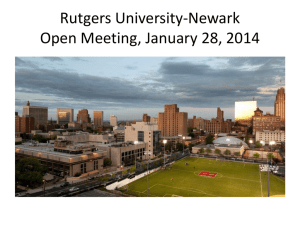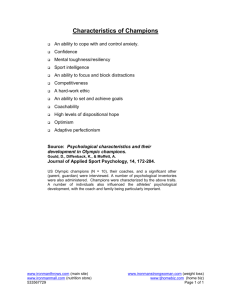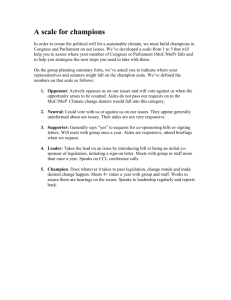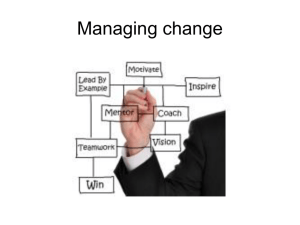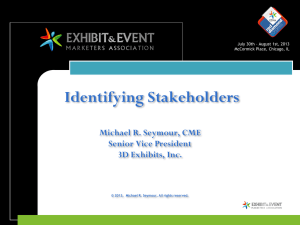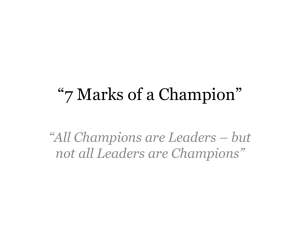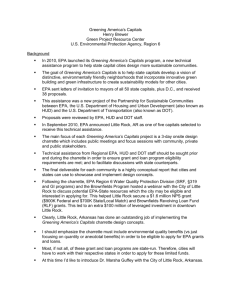Canaveral National Seashore Greening Charrette January 18-20, 2005 Titusville, Florida
advertisement
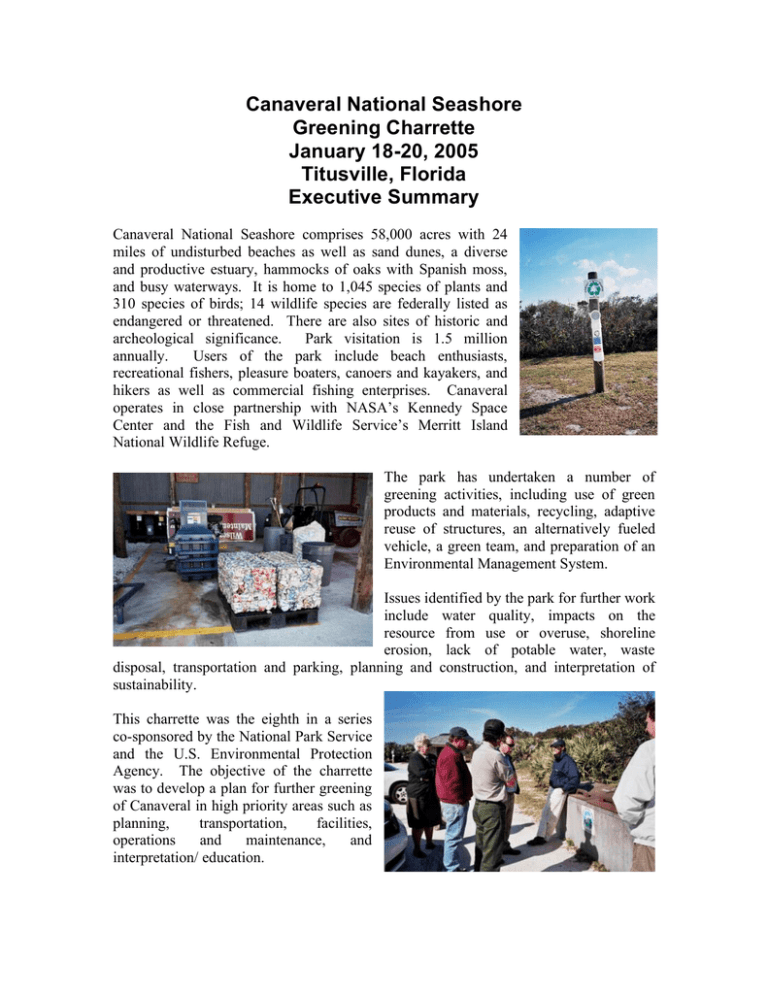
Canaveral National Seashore Greening Charrette January 18-20, 2005 Titusville, Florida Executive Summary Canaveral National Seashore comprises 58,000 acres with 24 miles of undisturbed beaches as well as sand dunes, a diverse and productive estuary, hammocks of oaks with Spanish moss, and busy waterways. It is home to 1,045 species of plants and 310 species of birds; 14 wildlife species are federally listed as endangered or threatened. There are also sites of historic and archeological significance. Park visitation is 1.5 million annually. Users of the park include beach enthusiasts, recreational fishers, pleasure boaters, canoers and kayakers, and hikers as well as commercial fishing enterprises. Canaveral operates in close partnership with NASA’s Kennedy Space Center and the Fish and Wildlife Service’s Merritt Island National Wildlife Refuge. The park has undertaken a number of greening activities, including use of green products and materials, recycling, adaptive reuse of structures, an alternatively fueled vehicle, a green team, and preparation of an Environmental Management System. Issues identified by the park for further work include water quality, impacts on the resource from use or overuse, shoreline erosion, lack of potable water, waste disposal, transportation and parking, planning and construction, and interpretation of sustainability. This charrette was the eighth in a series co-sponsored by the National Park Service and the U.S. Environmental Protection Agency. The objective of the charrette was to develop a plan for further greening of Canaveral in high priority areas such as planning, transportation, facilities, operations and maintenance, and interpretation/ education. The event began with a half-day tour of the site, designed to introduce speakers and other outside participants to issues at Canaveral that might be addressed during the charrette. The tour began at Park Headquarters in Titusville and included both South and North Districts. The group visited maintenance areas, parking areas and comfort stations, historic and archeological sites, and beaches. The first full day of the charrette began with a welcome from Carol Clark, Superintendent at Canaveral. Then, Shawn Norton, NPS Environmental Leadership Coordinator, set the stage for the charrette with an overview of sustainability in the NPS. The first session was a presentation of issues at Canaveral and goals for the charrette by John Stiner. Next, Gail Lindsey introduced the sustainability topics that are the focus of this charrette series: environmental leadership and planning, transportation, facilities, operations and maintenance, concessions, interpretation and education, and procurement. After lunch, Ben Pearson of Cape Cod National Seashore discussed ideas and success stories related to facilities and transportation. Then, Sonya Capek of the NPS Pacific West Region discussed green purchasing and waste management. Finally, Diane Liggett of Harpers Ferry Center presented principles for communications, interpretation, and education and examples of successful programs. Participants then broke into three work groups to discuss ideas for (1) planning, facilities, and transportation (2) green purchasing and waste management, and (3) interpretation and education. For the remainder of the day, the groups discussed a vision for their topic and the current status at Canaveral to create a baseline. The work groups returned the final day to establish short-term, mid-term, and long-term goals and actions; the groups also identified champions and partners for high-priority actions as well as funding requirements. At the conclusion of the charrette, the groups presented their results and Superintendent Carol Clark reacted to the groups’ priorities. Priority Short-Term Goals/Actions Planning Ensure environmental leadership language is incorporated into the GMP (LEED ratings for facilities included in GMP, ideas from greening charrette) Complete and submit Environmental Management System (EMS) and issue a press release/ internal information to publicize the mission statement of the EMS Facilities and Landscape Re-establish recycling committee and prepare a recycling plan Prepare a Solar Application Plan Investigate feasibility of converting comfort stations Transportation Edit existing equipment replacement statements for alternative fuels (find vendors for fuels and biobased lubes and edit PMS transportation study project) Monitor and review existing FWS study for practicality of expanding no-motor or electric motor only zone Green Purchasing/Waste Management Inventory products currently used in the park Initiate working relationship with NASA Assess training needs and conduct training on greening for park staff Communicate with staff (commitment to sustainability, ideas for EMS) Interpretation/Education Prepare news release about charrette Update Daily Alert to include sustainability messages and sign-off Tell volunteers about charrette and greening effort at upcoming Volunteer Picnic Conduct a familiarization tour for nearby tourist industry that includes sustainability messages Place new recycle bin at Visitor Center and improve signage on existing bins Investigate use of electronic reading boards on highway approaches for parking information and sustainability messages Introduce greening initiatives at next scheduled volunteer brown bag lunch and follow up with regular discussions Champions GMP team Tim Morgan, Candace Carter, Lisa Donnelly Bruce Rosel, Vince DiDio Maintenance Resource Management Martha Schaffer Carol Clark Laura Henning, Christin Poole Carol Clark, Rosemary Williams, Lisa Donnelly, Candace Carter Laura Henning, Carol Clark Rosemary Williams Laura Henning, Christin Poole, Carol Clark Laura Henning, Christin Poole Shawn Harris, Laura Henning Laura Henning Laura Henning and staff as needed Canaveral National Seashore Greening Charrette January 18-20, 2005 Titusville, Florida Final Report Background Canaveral National Seashore comprises 58,000 acres with 24 miles of undisturbed beaches as well as sand dunes, a diverse and productive estuary, hammocks of oaks with Spanish moss, and busy waterways. It is home to 1,045 species of plants and 310 species of birds; 14 wildlife species are federally listed as endangered or threatened. There are also sites of historic and archeological significance. Park visitation is 1.5 million annually. Users of the park include beach enthusiasts, surfers, recreational fishermen/ women, pleasure boaters, canoers and kayakers, and hikers as well as commercial fishing enterprises. Canaveral operates in close partnership with NASA’s Kennedy Space Center and the Fish and Wildlife Service’s Merritt Island National Wildlife Refuge. Portions of the park are owned by NASA and some is co-managed with FWS. The park has undertaken a number of greening activities. For example, composite lumber is used to replace boardwalk lumber and in construction of trash and recycling receptacles; old tires are used to make hinges for these receptacles. Aluminum cans and monofilament fishing line are recycled. Facilities have been adapted for reuse as they become available. An alternatively fueled vehicle has been acquired. A green team is active and preparation of an Environmental Management System is underway. Issues identified by the park for further work include water quality, impacts on the resource from use or overuse, shoreline erosion, lack of potable water, waste disposal, transportation and parking, planning and construction, and interpretation of sustainability. Charrette Overview This charrette was the eighth in a series co-sponsored by the National Park Service and the U.S. Environmental Protection Agency. The objective of the charrette was to develop a plan for further greening of Canaveral in high priority areas such as planning, transportation, facilities, operations and maintenance, and interpretation/ education. The event began with a half-day tour of the site, designed to introduce speakers and other outside participants to issues at Canaveral that might be addressed during the charrette. The tour began at Park Headquarters in Titusville and included both South and North Districts. The group visited maintenance areas, parking areas and comfort stations, historic and archeological sites, and beaches. The first full day of the charrette began with a welcome from Carol Clark, Superintendent at Canaveral. Then, Shawn Norton, Environmental Leadership Coordinator for the NPS, set the stage for the charrette. He discussed current and past leadership of the NPS in sustainability and emphasized the need to change behavior through tools, training, demonstrations, communication, and partnerships. The first session was a presentation of issues at Canaveral and goals for the charrette by John Stiner. He described the ecological resources, facilities, usage, and partners at Canaveral as well as an overview of some of the park’s accomplishments. High priority issues include water quality, use and overuse of the resource with resulting ecological impacts, shoreline erosion, lack of potable water for workers and operations, solid waste (from visitors and washing up on beach), visitor transportation and parking, planning and renovation of facilities, and communication with visitors prior to and during their visits. Next, Gail Lindsey introduced the sustainability topics that are the focus of this charrette series: environmental leadership and planning, transportation, facilities, operations and maintenance, concessions, interpretation and education, and procurement. After lunch, Ben Pearson of Cape Cod National Seashore discussed ideas and success stories related to facilities and transportation. He presented examples from his experience including use of green materials, green cleaning products, energy efficiency and green power, water use, grounds maintenance, greener vehicles and maintenance products, and visitor transportation. A partnership with the local communities resulted in a transit system for the entire area, including the park and local communities. Then, Sonya Capek, Pacific West Region Environmental Program Coordinator, discussed green purchasing and waste management. She discussed specific examples of green office products and waste management strategies as well as tools and resources. Finally, Diane Liggett, a communications specialist from the Harpers Ferry Center, presented principles for communication, interpretation, and education and examples of successful programs. She emphasized the importance of including interpretation staff in division planning sessions so they can issue press releases on accomplishments and organize regular brown bag lunches to communicate these successes to other staff and friends. She also noted how an NPS Sustainability Education and Partnership Plan, if developed, could provide consistent Systemwide messages and outlines for specific educational products. Participants then broke into three work groups to discuss ideas for (1) planning, facilities, and transportation (2) green purchasing and waste management, and (3) interpretation and education. For the remainder of the day, the groups discussed a vision for their topic and the current status at Canaveral to create a baseline. The work groups returned the final day to establish shortterm, mid-term, and long-term goals and actions; the groups also identified champions and partners for high-priority actions as well as barriers and opportunities and approximate level of cost. At the conclusion of the charrette, the groups presented their results and Superintendent Carol Clark reacted to the groups’ priorities. Highlights of Discussion Planning, Transportation, and Facilities Team: Candace Carter, Vince DiDio, Lisa Donnelly, Shawn Harris, Tim Morgan, Ben Pearson, Bruce Rosel, Jon W. Steil Planning Vision: keep environmental leaderships as the focus of Canaveral; create new partnerships and improve existing partnerships with NASA and friends group; include sustainability considerations in planning—development planning, LEED for facilites, alternative transportation throughout the park; complete the EMS by December 2005 – incorporate into employee performance standards and publicize mission statement widely. Current Status/ Baseline Conditions • GMP o 1981 GMP exists o Denver Service Center is on board to review and revise GMP o Transportation study was done for North District o Planner has been assigned o FWS and NASA are partners o Public input has started o Issues include balancing visitor use and resource conservation – lagoon, beach, dunes – carrying capacity • EMS o Vision/ commitment statement in place o Team in place, following existing model o Other priorities (hurricanes) have interfered o Assets/ impacts underway Short-Term Goals and Actions • Ensure environmental leadership language is incorporated into the GMP (LEED ratings for facilities included in GMP, ideas from greening charrette) Champion: GMP Team Partners: Denver Service Center, Superintendent, Regional office Funding: $$ • Increase contact with partners and Friends groups Champion: GMP team Partners Funding: $ • Complete and submit Environmental Management System (EMS) and issue a press release/ internal information to publicize the mission statement of the EMS Champions: Tim Morgan, Candace Carter, Lisa Donnelly Partners: EMS team Funding: $ • Inventory products in use Champion: Shawn Harris Partners: Maintenance staff, Ranger division Funding: $ • Write new employee performance standards Champions: Supervisors Partners: EMS team Funding: $ Mid-Term and Long-Term Goals and Actions • Make contact with new partners and friends Champion: GMP team Partners: Funding: $ • Continue contact with existing partners and friends Champions: GMP team (John Stiner) Partners Funding: $ • Conduct annual review of EMS plan and goals Champion: Lisa Donnelly Partners: EMS team, Bruce Rosel, Carol Clark • • Funding: $ Write PMIS entries to meet EMS goals Champion: Tim Morgan Partners: Division chiefs, supervisors Funding: $ Prepare annual press releases Champions: Tim Morgan, Candace Carter Partners: EMS team Funding: $ Transportation Vision: prepare transportation study for whole park; increase use of alternative modes of transportation into and around the park – alternative fuels for 100% of park owned or operated vehicles, park bike trail at north end; improve north-south connection; consider no-motor or electric motor only zone in lagoon. Current Status/Baseline Conditions • Limited use of alternative modes of transportation around the park • Parking limited and lots fill on busy weekends in the North District • No bike trails in the park or adjacent to the park • No regional transit system • Distance between North and South Districts with no connection of the two areas • No employee transportation system, though there is some carpooling • Transportation study completed for North District only • One hybrid vehicle in fleet Short-Term Goals and Actions • Edit existing equipment replacement statements for alternative fuels o Find vendors for fuels and biobased lubricants o Edit PMIS transportation study project Champions: Bruce Rosel, Shawn Harris Partners: NASA, FWS, Region, Martha Schaffer, Facility Manager, GSA Fleet Management Funding: $ • Monitor and review existing FWS study for practicality of expanding the nomotor or electric motor only zone in Mosquito Lagoon Champion: John Stiner Partners: FWS, Candace Carter, NASA, State Funding: $$ • • Edit existing request for funding to include short term transportation plan or study for whole park Champions: Vince DiDio, Bruce Rosel Partners: Regional Contact, K. Cockram Funding: $ Use partner (Rails to Trails) to investigate feasibility of bike trails (survey) Champions: Candace Carter, Lisa Donnelly Partners: Matt Cairo, E-Z Riders Funding: $ Mid-Term and Long-Term Goals and Actions • Start implementation of transportation study recommendations Champion: Carol Clark Partners: Local transit authority, Florida Department of Transportation, Federal Highway Administration, local towns Funding: $$$ • 100% use of biobased fuels, lubricants, etc. as feasible Champion: Vince DiDio Partners: Facility management, NASA, FWS, Region Funding: $ • Request funding for long-term transportation needs study Champion: Bruce Rosel Partners: Region Funding: $ • Request funding for bike trail system design/ construction if feasible Champions: Lisa Donnelly, Candace Carter Partners: Federal Highway Administration, Region, County, User clubs Funding: $ • Obtain public input on no-motor or electric motor only access Champion: John Stiner Partners: FWS, State, NASA, users Funding: $-$$ • Request/ consider alternative fuel vehicles for all replacements from GSA Champion: Martha Schaffer Partners: Division chiefs Funding: $ Facilities Vision: use plastic wood on 50% of boardwalks and rails; convert comfort stations to chemical-free; eliminate glass in park; provide better education for employees; provide better signage for recycling; track information on waste generation in park; consider solar applications in parking/ boat ramps/ comfort stations/ fee booth Current Status/ Baseline Conditions • Close to 100% changeout of T32 to T8 lamps • 10% use of plastic lumber • Chemical comfort stations • No renewable energy use • No potable water in South District; North District water system hard to maintain • Wastewater pumpout in South District • Facilities deteriorate faster in Canaveral climate • Park generated waste is recycled well; visitor waste recycling and diversion is low Short-Term Goals and Actions • Re-establish recycling committee and prepare a recycling plan using the ISWAP as a basis Champions: John Stiner, Rob Leonard Partners: Bruce Rosel, Shawn Harris Funding: $ • Prepare a Solar Application Plan (SAP) Champion: Bruce Rosel Partners: DOE, Region Funding: $$ • Investigate converting comfort stations to non-chemical toilets Champion: Vince DiDio Partners: Vendors, Region Funding: $ • Educate employees – make them more aware of green practices Champion: Tim Morgan Partners: NASA, NPS, Cape Cod, Egov Funding: $ • Conduct waste diversion exercises quarterly Champions: Shawn Harris, Bruce Rosel Partners: Staff, recycling committee Funding: $ Mid-Term and Long-Term Goals and Actions • 100% of boardwalks funded will be recycled content plastic lumber Champions: Shawn Harris, Bruce Rosel Partners: Unilever, recycling vendors Funding: $$ • Seek funds for conversion of comfort stations to non-chemical toilets Champion: Vince DiDio Partners: Region, Denver Service Center Funding: $$$ • Revise compendium to eliminate glass in the park Champions: Tim Morgan, Carol Clark Partners: Maintenance, fee Funding: $ • Design/ purchase signage for recycling Champion: Sign/ recycling committee Partners: Park Funding: $$ • Conduct waste diversion exercises quarterly Champions: Shawn Harris, Bruce Rosel Partners: Staff, recycling committee Funding: $ • Investigate alternatives for solid waste disposal Champion: Bruce Rosel Partners: Recycling committee, counties Funding: $ • Increase diversion rate for waste Champion: Bruce Rosel Partners: Recycling committee, counties Funding: $ • Implement recommendations of Solar Application Plan and measure success Champions: Bruce Rosel, Shawn Harris Partners: FSC, Department of Energy Funding: $$$$ Green Purchasing and Waste Management Team: Sonya Capek, Arnie Dumsha, John Hoover, Greg Robinson, Martha Schaffer, Julie Shannon, Shannah Trout, Rosemary Williams Vision: Canaveral has a staff and management team educated and aware of green activities and products; visitors are educated about green products and efforts in the park; park shares its successes with other parks; park recycles to the maximum extent possible; park’s new EMS drives the park’s greening efforts. Current Status/ Baseline Conditions • Currently recycling paper, ink cartridges, aerosol cans, oil, batteries, cans, fluorescent light bulbs, fishing line – not glass or plastic • Park has a green team/ EMS team • Some purchasing done through NASA • Cleaning products all biobased • Leasing vehicles from GSA – does not allow use of retread tires • Lifespan of vehicles in Canaveral climate is short • Most visitors get information on park at Headquarters and the North District Visitor Center • Approximately 1.5 million visitors annually Short-Term Goals and Actions • Inventory products currently used in the park Champion: Martha Schaffer Partners: Divisions, Arnie Dumsha, Louis, Mike Funding: none Timetable: start April 2005 • Initiate working relationship and environmental partnership with NASA and its greening team Champions: Carol Clark, EMS team Partners: NASA (Diane Collier) Funding: none Timetable: July 2005 • Assess training needs and conduct training on greening for staff o Contracting and purchasing • staff – how to purchase green easily, solid waste collector, CPG (recycled content) items o Facilities/ maintenance staff – what to ask for, what products are recyclable o Other staff and volunteers – general sustainability, get everyone bought into and excited about sustainability efforts Champions: Laura Henning, Christin Poole Partners: Shannah Trout (NASA contractor) and KSC Funding: none Timetable: start in March 2005 Communicate with staff o Carol Clark communicates commitment to staff Champions: Carol Clark, Rosemary Williams Partners: none Funding: none o EMS team asks all staff for ideas Champions: Lisa Donnelly, Candace Carter Partners: none Funding: none Mid-Term Goals and Actions • Prepare a display for visitors on park’s green efforts and products used Champions: Laura Henning, Christin Poole, with EMS team • Develop brochures to go with the display – what the park is doing and what visitors can do Champions: Laura Henning, Christin Poole, with EMS team • Develop better signage for recycling areas (bilingual?) Champion: Sign committee • Start recycling glass and plastic in the park Champions: Bruce Rosel, Arnie Dumsha, Shawn Harris Partners: NASA (contact Alice Smith – NASA recycling coordinator), FWS, local governments • • Pursue getting Department of Energy audit Champion: Vince DiDio contact Gregory Begin tracking quantity of waste being generated Champions: Martha Schaffer, Arnie Dumsha Interpretation and Education Team: Laura Henning, Elizabeth Knegeris, Diane Liggett, Christin Poole, Pat Skrtic, John Stiner, Joel Ann Todd Vision: Inspire visitors and potential partners to become more aware of Canaveral National Seashore’s unique qualities, why they enjoy this special place, and why it is important to them and their children. Provoke visitors to make connections between their lifestyles and conditions in the park and on the planet. Promote seamless and constructive communication between park divisions to produce practical take-home messages. Work to preach what we practice by routinely acknowledging the park’s successes in the area of sustainability. Current Status/ Baseline Conditions • Current activities of interpretation/ education staff include staffing the Visitor Center and issuing permits, educational programs at the North District, scheduling volunteers, giving pontoon boat rides, preparing waysides and bulletin boards, press releases, turtle watches, and more • Communication among divisions is good • With more time, they could do much more – there is no time to develop new programs • South District has very little interpretation and education except turtle watch – there are no interpretive staff in South District now and security has been a barrier (closings have discouraged visitors – they try to attend events and cannot enter so they do not come back) • Volunteers are great but some are seasonal and many do other volunteer work (North District has a larger potential pool of volunteers since there are more retirees in that area) • Visitors often confuse NPS and FWS lands and management • • • • There is a need to communicate with visitors before they reach the park about parking, what to expect, nature of the park and resource Paddler clubs are active and could be partners in recruiting canoe and kayak users Web site is updated by staff at park headquarters Many condo buildings have in-house cable TV station that might provide an opportunity for communication with visitors Short-Term Goals and Actions • Prepare news release about the charrette Champions: Laura Henning, Carol Clark Partners: none Funding: none Timetable: January 24, 2005 • Update Daily Alert to include sustainability messages and sign-off Champion: Rosemary Williams Partners: all staff with “news” Funding: none Timetable: January 24, 2005 • Tell volunteers about charrette and greening efforts at upcoming Volunteer Picnic Champions: Laura Henning, Christin Poole, Carol Clark Partners: John Stiner Funding: none additional Timetable: January 29, 2005 • Conduct a familiarization tour for nearby tourist industry that includes sustainability messages Champions: Laura Henning, Christin Poole Partners: Dixie Crossroads (lunch), Florida Solar Energy Center (alternative fuel bus), Chamber of Commerce Funding: $$ Timetable: Tour November 2005 • Place new recycle bin at Visitor Center and improve signage on existing bins to improve separation of cans from wet trash Champions: Shawn Harris, Laura Henning • • • • • • • • • • • Partners: Funding: $ from recycling account Timetable: by August 30,2005 Investigate use of electronic reading boards on highway approaches for parking information and sustainability messages Champion: Laura Henning Partner: City of New Smyrna Funding: $$ Introduce greening initiatives at next scheduled volunteer brown bag lunch and follow up with regular discussions Champion: Laura Henning Partners Funding: none Check out Space Center newsletter (and other partner publications) to see if Canaveral can contribute regular articles on greening activities Include a green link on the park profile on the Web site Add take-home trash message to school program preparation Develop environmental education partnership with the Marine Science Center at Ponce Inlet Recognize existing partners (e.g., Unilever, NASA) Work to obtain and distribute “Save our Lagoon” brochure and other relevant brochures Continue water quality and conservation messages in interpretive programs Use roving volunteers to help transmit sustainability messages Develop an Earth Day activity and messages Mid-Term Goals and Actions • Consider developing audio driving tour of park with green messages (CD rental?) • Develop informational brochure with NASA Space Center to provide green messages to visitors, travel and tourism industry • • • • • • • • • • • Incorporate educational components in alternative transportation plan Redesign portable exhibit for outreach Work on water quality and conservation brochures and programs with partners Contact Rails to Trails and bicycle groups to evaluate biking opportunities in the park Conduct outreach to kayakers and canoers Establish volunteer green team Work to broaden Friends of Eldora group to be a Friends of Canaveral group to take on additional projects, without compromising work at Eldora Investigate PMIS and OFS funding for additional interpretive positions at South District and other locations Formalize the outreach plan with more involvement from Friends group and volunteers Consider a contest for school children at Earth Day – poster contest, etc. – and make sure home schooled children are included Obtain graphics for alternative fuel vehicles to transmit message Long-Term Goals and Actions • Work with partners throughout the region to contribute greening articles to their publications • Continue volunteer newsletter and include greening messages • Contact Space Center to update orientation to Canaveral exhibit • Develop involvement plans for parking, shuttles, enhancing low-impact visitation • Sustain cultural identifies and practices through education (e.g., Eldora, shellfish fishing, etc.) Closing At the final report out, each group presented its highest priority actions for the upcoming year. The group at large listened and then discussed all the items in terms of feasibility. The list of priority items are shown below noting specific champions who will be the “responsible parties” to undertake the priority action items. Priority Short-Term Goals/Actions Planning Ensure environmental leadership language is incorporated into the GMP (LEED ratings for facilities included in GMP, ideas from greening charrette) Complete and submit Environmental Management System (EMS) and issue a press release/ internal information to publicize the mission statement of the EMS Facilities and Landscape Re-establish recycling committee and prepare a recycling plan Prepare a Solar Application Plan Investigate feasibility of converting comfort stations Transportation Edit existing equipment replacement statements for alternative fuels (find vendors for fuels and biobased lubes and edit PMS transportation study project) Monitor and review existing FWS study for practicality of expanding no-motor or electric motor only zone Green Purchasing/Waste Management Inventory products currently used in the park Initiate working relationship with NASA Assess training needs and conduct training on greening for park staff Communicate with staff (commitment to sustainability, ideas for EMS) Interpretation/Education Prepare news release about charrette Update Daily Alert to include sustainability messages and sign-off Tell volunteers about charrette and greening effort at upcoming Volunteer Picnic Conduct a familiarization tour for nearby tourist industry that includes sustainability messages Place new recycle bin at Visitor Center and improve signage on existing bins Investigate use of electronic reading boards on highway approaches for parking information and sustainability Champions GMP team Tim Morgan, Candace Carter, Lisa Donnelly Bruce Rosel, Vince DiDio Maintenance Resource Management Martha Schaffer Carol Clark Laura Henning, Christin Poole Carol Clark, Rosemary Williams, Lisa Donnelly, Candace Carter Laura Henning, Carol Clark Rosemary Williams Laura Henning, Christin Poole, Carol Clark Laura Henning, Christin Poole Shawn Harris, Laura Henning Laura Henning messages Introduce greening initiatives at next scheduled volunteer Laura Henning and staff as brown bag lunch and follow up with regular discussions needed Following this presentation, Superintendent Carol Clark, who had attended the entire charrette, responded to the presentation of high priority actions for the upcoming year. “We can do this” she said. “I see nothing that can’t be done in the first year.” She was particularly pleased that “we have tied it all together with other plans we’re doing.” Finally, Carol, the park’s steering committee, and Gail Lindsey and Joel Todd, the consultants to NPS on this greening effort, ended the charrette with thanks to all and a reminder that the National Park Service will be contacting the park in six months to check on progress. Thanks again to all the coordinators, facilitators, presenters, and participants who made this Greening Charrette a success!
